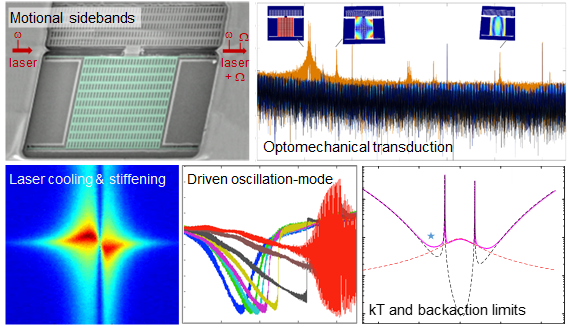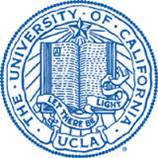
Mesoscopic Optics and Quantum Electronics Laboratory
Our team advances mesoscopic physics and precision measurements at fundamental limits and in accelerated technology transitions. Our chip-scale devices span foundational measurements, foundry and high-performance nanofabrication, and numerical modeling and theory. Our examinations are in four core Thrusts areas: Precision Laser Frequency Combs | Cavity Quantum Optomechanics | Superconducting Qubits and Small-scale Microprocessors | and Quantum Networks and Mesoscopic Spectroscopy, in collaboration with industry, startups, foundries and national laboratories. Our studies are at the interface of Applied Physics, Engineering, and Mesoscopic Device Physics.
Our efforts are enabled by kind support from the National Science Foundation, the Department of Defense, NASA, DARPA, the Department of Energy, the National Institutes of Health, University of California, industry, national laboratories and early-stage entrepreneurs. Below we highlight these research and technology Thrusts.Precision Laser Frequency Combs | Cavity Quantum Optomechanics | Superconducting Qubits and Small-Scale Microprocessors | Quantum Networks and Mesoscopic Spectroscopy

Microelectronics foundries enable scaled Josephson junction qubits towards quantum information processing. When cooled to sub-20-mK temperatures, the superconducting-insulator-superconducting qubits have recently witnessed non-classical and hybrid computations with accelerated time-to-solution in computational tasks. This enables distinct quantum advantage in combinatorial optimization, quantum AI, accelerated gradient computations in hybrid quantum – classical systems, and materials computation.
Our team is examining (1) new generation high-performance Josephson junction qubits including two-qubit gates of the highest fidelity; (2) small-scale microprocessors in 1D and 2D lattice tomography for mapping the error propagation, mitigation and suppression; and (3) planar architectures of resonator-based qubits for efficient quantum error correction. In the first topic, understanding the noise and error sources are being advanced including the device designs, foundry processing, and RF pulses and readout. Hardware-efficient Clifford and non-Clifford gates, high-dimensional excitations in the Jaynes-Cummings ladder, along with multi-mode coupled subsystems are examined.
In the second topic, scaled qubits in high-performance coupled gate sets are investigated, including residual errors, efficient tomography, circuit synthesis and multiplexing approaches. This also includes low-noise on-chip microwave generators and integrated isolators. Understanding the error propagation, mapping the error mitigation, suppression and correction are key objectives of our studies. In the third topic, we have achieved planar Q in excess of 1M, enabling bosonic qubits and photon-number encoding. With novel coupled ancilla qubits, hardware-efficient components are investigated towards demonstrators.

Enabled by ultrafast optical nonlinearities and high quality factors Q more than 1 million in wavelength-scale cross-sections, our team has advanced chip-scale mesoscopic resonators with cascaded four-wave mixing. This enables high-performance laser clocks, fundamental studies of nonlinear dynamics, ultralow-noise RF and millimeter wave generation and detection, spectroscopy of trace molecules at stand-off distances, light detection and ranging, Tb/s optical and millimeter transceivers, and dense massively-scaled atomic-light interactions.
With unique driven protocols and high spectral-purity lasers, fundamental bounds on the femtosecond laser frequency combs are continuously advanced by our team, at and beyond the thermodynamical noise envelopes and towards the quantum noise limits. Robust dispersion control in the wavelength-scale structures enable enhanced nonlinear interactions, parametric oscillators, and ultrafast pulse synthesis. Full comb stabilization and metrology for RF-optical clockwork are being investigated by our team, including carrier envelope phase offset and absolute definition of the color of light. Single-cycle clockwork, full- and multi-octave spectroscopy, and highly-efficient large nonlinearities via the engineered density of optical states are being advanced.
Furthermore, engineered microresonators with quality factors Q in excess of 100M has been demonstrated by our team, serving as reference or self-injection cavities for chip-scale lasers of sub-100-Hz integral linewidths. This also enables optical-to-microwave frequency division at the fundamental limits. Dual-mode stabilization for long-term subsystem and in-field demonstrators have also been contributed by our team in steady industry – national laboratories – university – startup partnerships.
With sub-wavelength localization and high quality factors in our mesoscopic optical resonators, the strong electromagnetic gradient enables dramatically large optical-to-motional transduction. Rabi-like frequencies of 700-GHz per nm of motional displacement has been examined which, when normalized by the zero-point motion, result in vacuum Rabi frequencies up to 2 MHz. Femtometer per root-hertz displacement spectral densities are consistently measured in our laser drive and readout, and at the thermodynamical (kT) bounds.
When red-detuned with drive laser frequency lower than the optical resonance, optomechanical cooling and softening has been achieved, even approaching the canonical quantum mechanical ground state. Conversely, when blue-detuned, optomechanical amplification and stiffening has been observed. Driven into oscillation-mode above threshold at 100-uW or less powers, the resulting blue-detuned phononic-like maser has narrow linewidths at few milli-Hertz per root-hertz frequency noise power spectral densities. This enables high sensitivity and ultralow-noise detection of fields and forces, across a myriad of applications.
Current examinations include large dynamic range in the laser-enhanced quantum sensing, common-mode noise suppression, and resolved-sideband detection limits. The driven optomechanical oscillator, when coupled with a second degree-of-freedom via electron-hole Drude plasma oscillation, further affords nonlinear dynamical studies such as chaos and subharmonics, unique phase portraits, and chaos-enabled secure communications. Packaging in high technology readiness level (TRL) in-field demonstrators are examined, towards subsystem and integrated prototyping in industry – federal agency – university accelerators.


